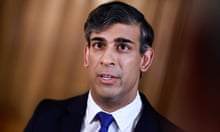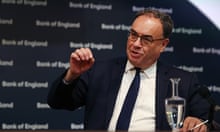The US is braced for an interest rate rise on Wednesday that could push the world’s largest economy into recession.
The Federal Reserve is expected to announce another quarter of a percentage point rise in its benchmark interest rate, to a range of 5% to 5.25%. It would be the central bank’s 10th consecutive rate rise as it prioritises the fight against rising prices. A year ago interest rates were close to zero.
Headline annual consumer inflation fell in the US in March, to 5% from 6%, but core inflation – which does not include volatile energy and food prices – edged up to 5.6% from 5.5%.
Economists are divided on whether the Fed should stop raising rates. Adam Posen, who runs the Peterson Institute thinktank in Washington DC, said it was important for the US central bank “to continue its hiking cycle given what the latest data is telling us”.
However, Robert J Shapiro, one of Bill Clinton’s economic advisers when he was president, said the Fed should stop in its tracks because it had done enough to calm the economy. Further rate rises risked a recession that was going to hurt low- and middle-income earners.
US economic growth slowed sharply in the first quarter of the year, to just 1.1% year-on-year, from 2.6% growth in the final three months of 2022. It was significantly less than the economists’ expectations of 2% growth.
“A decline in economic growth to 1.1% shows it is time for the Fed to pause,” Shapiro said.
“There is a significant lag between interest rate rises being imposed and them taking effect, and so we know there is more pain for the economy to come even without further rate rises.”
Neil Shearing, chief economist at the consultancy Capital Economics, said the Fed would increase rates by a quarter of a percentage point. “Then it’s done. And that’s because there are already significant signs the economy is slowing.
“The labour market is cooling and given all the problems in the US banking system and tightening lending conditions, there won’t be any call for higher rates,” he added.
A hike in interest rates in the US is expected to be followed on Thursday by a quarter of a percentage point increase in interest rates in the eurozone. The European Central Bank (ECB) is expected to raise its refinancing rate for a seventh consecutive time, to 3.75% and its deposit rate to 3.25%.
Next week the Bank of England is widely expected to hike interest rates for a 12th time in a row, taking them to 4.5%.
All are battling rapidly rising prices, but the inflation story is not the same everywhere.
While the headline rate came down in the US in the latest data for March, figures published on Tuesday showed eurozone inflation edged higher in April to 7% from 6.9%. In the UK, inflation dropped from 10.4% in February but remained stubbornly high in March at 10.1%.
after newsletter promotion
Yet central bank policymakers all sing the same tune because the measure of core inflation that strips out food, fuel and energy prices is well above the rate they find comfortable.
In March, core inflation reached 5.7% in the UK and the eurozone (before dropping to 5.6% in April in the single currency bloc), and 5.6% in the US.
It is part of the reason why policymakers says higher interest rates, which reduce the demand for goods and services, and consequently ease inflationary pressures, are needed.
The sticky nature of core inflation means there is no doubt in the mind of City analysts that interest rates in the US, UK and eurozone are about to head higher again. The only question is which central banks will think they have done enough and which will say they need to carry on beyond this month.
Posen was a dovish member of the monetary policy committee in the immediate aftermath of the 2008 financial crash, favouring lower rates and arguing at the time against those that wanted to increase borrowing costs to tackle rising inflation.
“I was described as an uber-dove. But this time the UK faces a different situation,” he said. “An additional raise by the Bank of England is a foregone conclusion and that is the right decision. The Bank is still behind the inflation curve, in my opinion.”
John Llewellyn, a former chief economist at the Organisation for Economic Cooperation and Development, said there was a strong chance the Bank of England and the ECB would be forced to continue raising rates until they see significant falls in core inflation.










